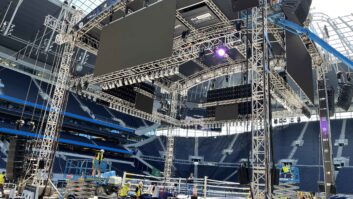Broadcast audio and location sound engineers sometimes (and quite rightly so) complain that they are never paid a compliment on an excellent audio job – audio only ever seems to get noticed when there is a glitch. Listening is so natural to an audience that only a fault in an otherwise perfect soundscape brings the audio part of broadcast to the forefront.
Although choosing the right microphone for the task at hand is critical, this is only part of the answer to capturing quality broadcast audio. Pre-planning, resourcefulness and creativity are just as important – and a hallmark of the experienced audio engineer. Broadcast recording tasks are as varied as life is, therefore preparedness and adaptability are key, as is gathering a few key pieces of information on the location and the interviewee, which will help immeasurably in making an informed microphone choice. Understanding the subject of the recording is the first step to a brilliant outcome.
Electronic news gathering (ENG)/outside broadcasting
Shall we call this the supreme discipline? Rushing to a news site not knowing what to expect is certainly stressful both from a personal and a professional perspective. A wireless system with a handheld for the reporter is a good microphone choice. The handheld also gives the reporter a comfortable amount of control when working with interview partners.
When a reporter is part of a larger crowd of colleagues trying to get a statement, a so-called reporter microphone is also a great choice. In addition to their ruggedness, they feature a long microphone body that gives the interviewer the few extra centimetres needed to be closer to an interviewee.
For more relaxed production jobs, reality shows, and any format that relies on a direct connection with the audience without the intermediary of a host or a reporter, you will want to swap the handheld for a tiny clip-on microphone that picks up the speaker. Choose an omni-directional clip on which is more forgiving when a speaker moves their head, and is also less sensitive to wind noise. The mic should be clipped to the clothing at about 20 cms from the mouth, and attention paid to mitigating issues such as muffling or scratching from fabrics as the wearer moves or accessories such as scarfs or jewellery getting in the way.

If the outside broadcast team includes a boom operator, a (short) shotgun microphone on a boom pole is a great choice, too. A boom microphone will also be helpful in capturing the overall soundscape that is needed to “anchor” a speaker within the location and set the scene, and to capture specific sounds that are elementary to the storytelling.
Whichever type of mic gets chosen, wind noise will always be a massive issue outdoors, so always make sure to bring blimps or hairy covers for your microphones, including the clip-ons. Furry windshields for the latter come in a range of colours, so can be easily matched to clothes where needed. Switch on the low-cut filter on your mic, and take enough batteries with you for the wireless.
The broadcast studio
Compared to outside broadcasting and ENG tasks, the studio seems like a haven of predictability, but challenges are lurking here too.

Freedom of movement more often than not dictates a wireless solution. Clip-on microphones paired with small bodypack transmitters that can be easily hidden in clothing are a standard. For talent who are active during a show or tend to move a lot in general, a headset microphone that keeps the microphone in a constant position with regard to the mouth may be the better choice. For the sound tech, it is of utmost importance to securely attach the bodypack transmitter and clip-on microphone. Thin fabrics and refined costumes can become a nightmare, and watching a clip-on slowly travelling down a lapel is a horror movie. Time to get out that spare handheld!
Sports broadcasting
Robustness and reliability are a huge consideration for sporting applications. Audio engineers can weigh in with all their expertise, as repositioning microphones during a match or a sporting event is not an option.
Audiences at home demand more access to the action and microphones play a large part in drawing the audience in. Referee mics are commonplace, as are shotgun microphones on the edges of tennis courts, football pitches and even at the end of motor races. Audience around the globe are fully involved in the sport thanks to the microphones in use. Shotgun microphones play a special role in sports broadcasting due to their climate-proofness and reach.
Immersive productions
Immersive sound has developed massively over the last five to ten years, and it has become easier than ever before to create 3D audio tracks. While audio professionals will lean towards to more refined (and expensive) setups indoors, especially for music formats, there are quite straightforward ways to capture immersive audio in the field. An Ambisonics microphone is ideal for creating an immersive basis that can be elevated with spot microphones.
YouTubing
The professionalisation of YouTubers has been an unbroken trend for many years, and many YouTubers own studios that boast the very latest in production gear. An ideal audio setup is a shotgun microphone angled from the top and an additional clip-on microphone. If you have to opt for one, choose the shotgun as it will give you richer sound but remember to stay within the pick-up area.
Microphones are a critical and integral part of broadcasting. Audio has the potential to make or break a programme or streaming event. Careful consideration in advance of any recording will ensure it is a true representation of the event or performance and will smooth out the process, leading to a more creative and exciting experience for the audience.







